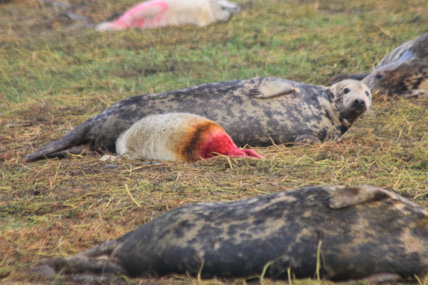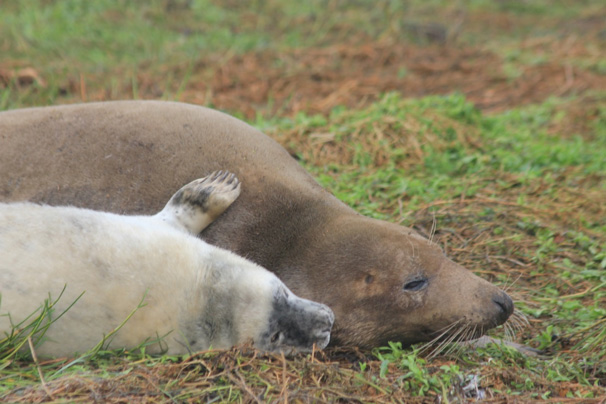Update.
With the pup count on the Islands already over 1600 this year with just a few weeks left, we are already above last year’s total of 1575. Pups have been arriving at some rate, peaking around mid-November and beginning to tail off now. However once the pups leave their mothers at around 3 weeks of age they begin to moult.
Pups at this stage are known as moleys, they become inquisitive, playful and highly entertaining to watch. With newly stored fat layers, weighing an average of 45kg and looking like mini seal Michelin men, they also find it difficult to move and even groom themselves.
 With more pups weaning, more moleys start to appear and congregate in moley groups or crèches around the outskirts of haul outs. They stay away from the aggressive nature of bulls and protective mothers. They stick together and appear to just relax and take in new aspects of life including the taste of grass…… (No they don’t eat grass)
With more pups weaning, more moleys start to appear and congregate in moley groups or crèches around the outskirts of haul outs. They stay away from the aggressive nature of bulls and protective mothers. They stick together and appear to just relax and take in new aspects of life including the taste of grass…… (No they don’t eat grass)
 They stay together sometimes in groups of more than 20 at times, for an estimated 2 weeks before venturing off into the water and the big wide world.
They stay together sometimes in groups of more than 20 at times, for an estimated 2 weeks before venturing off into the water and the big wide world.
What am I doing out here and why?
I am here researching and observing behavioural data between mothers and pups. I’m looking into multiple parameters surrounding this behaviour which will be crucial in understanding the population dynamics.
Behavioural work hasn’t actually been conducted on the Islands since the 1950’s so the work on this grey seal colony will be important not only for the U.K, but for the worldwide population.
Behaviours such as, grooming, nursing, aggression, playing, resting and bathing are being recorded for individual mother pup pairs throughout the whole lactation period.
Pups across the Islands are sprayed dyed with non-harmful paint. This allows accurate counts as new colours are used each pup count so after a couple weeks we have a rainbow pup filled Island. The pups I am following are specially marked with double colours or patterns to be able to re sight individual pups each day in a non-intrusive manner.
 Observations are carried out at a safe and appropriate distance so no disturbance or disruption is caused to any of the seals. This is not only important for the bonding process of the pups but also to get accurate behavioural research.
Observations are carried out at a safe and appropriate distance so no disturbance or disruption is caused to any of the seals. This is not only important for the bonding process of the pups but also to get accurate behavioural research.
You may think that substrate or shore exposure may play the biggest role in site selection for mothers before giving birth. However, water sources such as ponds, pools and the sea shore actually have the largest influence on site choice. Multiple sites are being compared to measure the differences in behaviour and the reasons surrounding it between different water sources and timing in the season.
A lot more research is being carried out within the study period, such as the amount of parental separation time where mothers will go off to bathe, not feed. Mortality measurements and time lapse camera footage of whole populations as well as energy transfer between mother and pups through nursing times will also be recorded.
The findings of this project will provide better understanding of the factors affecting the population dynamics and behaviour of m/p relations on the Farne Islands and how this compares with the research currently around other populations. The project will also give advice on management and future projections for this population and further study needed to understand and maintain this population.  For more information please contact:
For more information please contact:
Robert (Bob) Hunt
Email: r.hunt@ncl.ac.uk
Marine Science MPhil Student

